
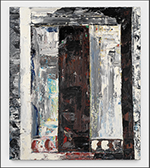
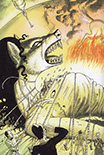
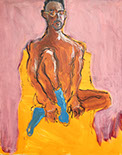

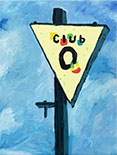

“Then Is Now: Contemporary Black Art in America”
The Bruce Museum, Greenwich, Connecticut, April 2–October 15, 2023
by D. Dominick Lombardi
The Bruce Museum redefines the importance of a regional museum. Situated in Greenwich, Connecticut, the newly renovated and beautifully expanded museum typically offers a blend of work from the 31,000 objects in their permanent collection and works on loan, in theme exhibitions. The excellent rotating curated exhibitions continue the institution’s 100 year-long mission to bridge the ever-decreasing gap between science and fine art.
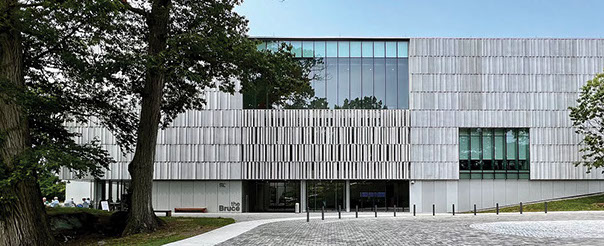
The Bruce Museum. Photo courtesy of the Bruce Museum.
An example of a theme exhibition that broadens the scope of their traditional programming, “Then Is Now: Contemporary Black Art in America” is an impressive look at important artists of the past 55 years who have addressed racial injustices throughout our nation’s history. When first entering the gallery, visitors come face to face with Hank Willis Thomas’s highly reflective lenticular work with text that changes from “Then Is Now” to “Then And Now'' depending upon where you stand. My first thought looking at this work is how much our current day socio-political status feels all too similar to past oppressive and transgressive behavior. This is especially true since some political extremists remain determined to roll back the clock by decreasing voting access, taking away women’s rights, and demonizing gender fluidity.
Two of the earliest works in the exhibition, which both address the mid-20th century state of the black female, are Charles White’s tempera painting Study for Seed of Love (1968-70) and Elizabeth Catlett’s Homage to My Young Black Sisters (1968). These two works could not be more different as White’s rather poetic representational figure depicted in profile appears to be distracted, minimized, or kept down (low in the picture plane), while bearing just enough inner strength to sway the day. Conversely, Catlett’s entrancing dynamic abstract wood sculpture with a gaping hole in the middle and one fist thrust in the air is overtly defiant, proud, and standing her ground. These two works, coupled with Melvin Edwards’ three welded steel wall reliefs that range in year of completion from 1964 to 2014, present a powerful picture of our nation’s history of slavery, Jim Crow, and racial violence.
Still photography documenting Dred Scott’s powerful 2009 performance I Am Not A Man shows the artist in Harlem, wearing a sign that states the work’s title. “I Am Not A Man” is a reference to the Memphis Sanitation Workers Strike of 1968, where the placard “I Am A Man” was seen as a basis for better treatment and wages. Scott is making reference not just to the 1968 strike, but to the thread that works its way throughout all the work here—that we have not yet reached true equality of all people—a goal that seems today to be closer to falling back than moving forward. In the artist’s NFT, a seven-minute slow motion video titled White Man for Sale, we see a depiction of a white male standing atop a two-step auction block on a street corner in Brooklyn. For the most part, passersby pay little attention to the ironic symbolism of the statement, which tells us something about the thought process in this black community. From that perspective, this could actually be possible—a result that speaks more clearly than any actual interaction with the subject might suggest.
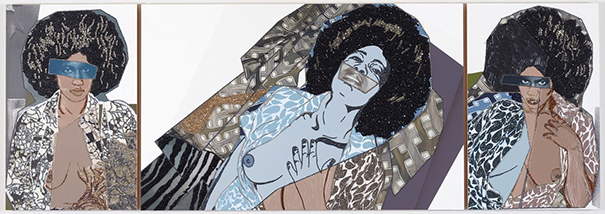
Mickalene Thomas, Untitled, 2013. Collage and mixed media, 34 x 96 ¾ inches. Photo: seavestcollection.org.
Mickalene Thomas’s mixed media triptych Untitled (2013) shows a young, beautiful black woman posing seductively as she gazes back at the viewer. The mix of vibrant patterns, glistening beads, mostly unmodulated browns and grays, and the selectively placed collage elements that make up areas of each face, suggest the balance between individual identity and the male objectification of women. In each panel, the hair makes its mark as a symbol of power and control to counter any compromising or unwanted narrative. The Gypsy Fortune-Teller (2007), a jacquard tapestry with a Kehinde Wiley painting as its design, continues a career-long desire for the artist to redefine, expand, and obliterate outdated stereotypical beliefs regarding men of color. The descriptive wall panel makes reference to the Rococo painter Francois Boucher who built a career on capturing the decadence of the aristocracy of late-18th-century Europe. I am getting more of a feeling of Michelangelo da Caravaggio’s Italian Baroque painting Bacchus (c. 1596), specifically in the unusual way that one figure in the foreground is holding their wine glass.

(Left) Kehinde Wiley, The Gypsy Fortune-Teller, 2007, detail. Jacquard tapestry in Merino wool and cotton, 76 x 102 inches. Photo: courtesy of the author. (Right) Michelangelo da Caravaggio, Bacchus (c. 1598), Oil, 37.4 x 33.4 inches, Wikimedia Commons.
Some of the more conceptual works in the exhibition are by Steve Locke, who uses a Josef Albers’ Homage to the Square (1950-75) aesthetic to expand the intention of Alber’s art—offering a new shape that relates directly to the auction blocks used during slavery. In addition to the import of the reference to the “somber memory of millions of lives lost to slave trade,” I find the color combinations in these works to be both alluring and Modernist in a very different way than the works of Albers (1888–1976)—perhaps it is the sense of finality projected by the colors of the shrinking planes. Betye Saar’s The Weight of Color (2007) focuses heavily on aspects of prejudice, most specifically how it relates to oppression, which in many ways still continues to be a major issue in society today. If visitors would take the time to really experience an assemblage like this—which features a complex narrative with a mammy figure, an old rusty scale, and a crow cramped into an undersized cage secured with a heavy lock—a clearer picture of the continuous weight of racism that people of color continue to bear can be more fully felt deep down, specifically by white people like myself.
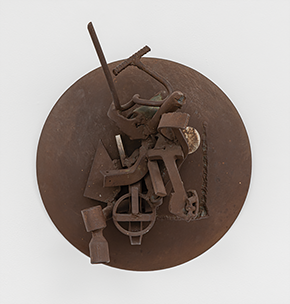
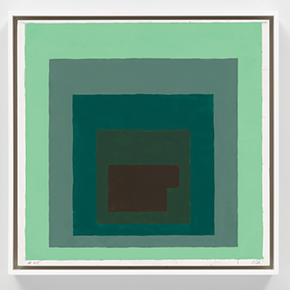
(Left) Melvin Edwards, Homage to James Benjamin Edwards, 1964. Welded steel, 20 x 17 x 11 1/2 inches. Courtesy of Michael Rosenfeld Gallery LLC, New York, NY. (Right) Steve Locke (American, b. 1963), Homage to the Auction Block #115-wander, 2021. Acrylic on panel, 16 3/4 x 17 1/8 x 2 1/4 inches. Courtesy Alexander Gray Associates, New York. © 2023 Steve Locke / Artists Rights Society (ARS), New York. Photos: Bruce Museum.
Emma Amos offers a similar message as the previously discussed artists, albeit a bit more directly. In the center of Mississippi Wagon 1937 (1992) sits the photograph mentioned in the work's title, which has very specific links to the heritage of the artist. Visually surrounding and simultaneously suffocating the vintage black and white photograph is a loosely rendered confederate flag. The colorful border, overflowing in historical associations, creates a target effect, thus compressing the narrative while focusing the viewer’s attention on the non-existent prospects for southern blacks during Jim Crow. Radcliffe Bailey’s multimedia Untitled (Blue Green Collage) (2018) also utilizes black and white photography and a colorful border. However, in this instance, the mood is more positive and prideful, while also incorporating reference to the artist’s own family history.
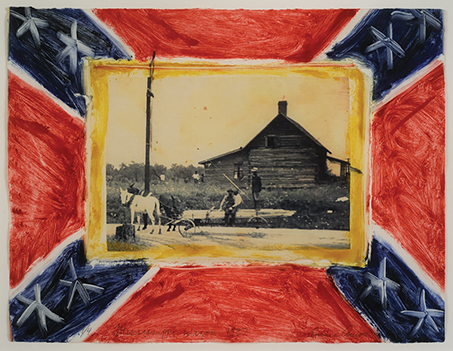
Emma Amos (American, 1937–2020), Mississippi Wagon, 1937, 1992. Oil, monotype, and
screenprint on paper, 15 ½ x 20 ¼ inches. From The Larry D. and Brenda A. Thompson
Collection. © Emma Amos; Courtesy of RYAN LEE Gallery, New York. Photo: Bruce Museum.
The most powerfully imposing work is Benny Andrews Poverty (America Series) (1990)—a somber narrative that points to the struggles of impoverishment. The incorporation of a dyed fabric that defines most of the subject's body position greatly enhances an incredibly bold, yet somber, composition. Much in the same vein of the great Jacob Lawrence (1917–2000), who too used a minimal earthy palette and angular forms, Andrews generates great depth of emotion and a visceral sensation of torment and persecution.
%20rgb.jpg?crc=3997696042)

(Left) Radcliffe Bailey, Untitled (Blue Green Collage), 2018. Archival photograph and mixed media. (RIght) Benny
Andrews, Poverty (America Series), 1990. Oil and graphite on paper with painted fabric collage, 50 x 39 inches.
Photos: courtesy of the author.
Also included in the exhibition are wonderful works by Jammie Holmes, Kenneth Victor Young, Titus Kaphar, Barkley L. Hendricks, Alison Saar, and Dawoud Bey. Kudos to the curator of the exhibition, Margarita Karasoulas, who presents a very thoughtful selection and arrangement of work.
D. Dominick Lombardi is a visual artist, art writer, and curator. A 45-year retrospective of his art recently traveled to galleries at Murray State University, Kentucky in 2019; to University of Colorado, Colorado Springs in 2021; and the State University of New York at Cortland in 2022.
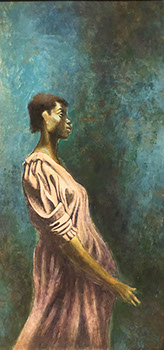

Left) Charles White, Study for Seed of Love, circa 1968–1970. Tempera on illustration board, 25 x 12 inches. Photo: courtesy of the author. (Right) Elizabeth Catlett, Homage to my young Black Sisters, 1968. Red cedar, with painted carved details, 68 x 12x 12 inches. Photo: swanngalleries.com.
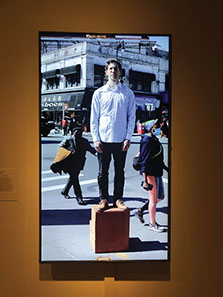
Dread Scott, White Male for Sale, 2021, NFT, 7:00 minutes. Photo: courtesy of the author.
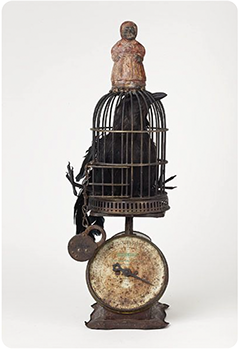
Betye Saar, The Weight of Color, 2007. Mixed-media assemblage. Photo: Pinterest.